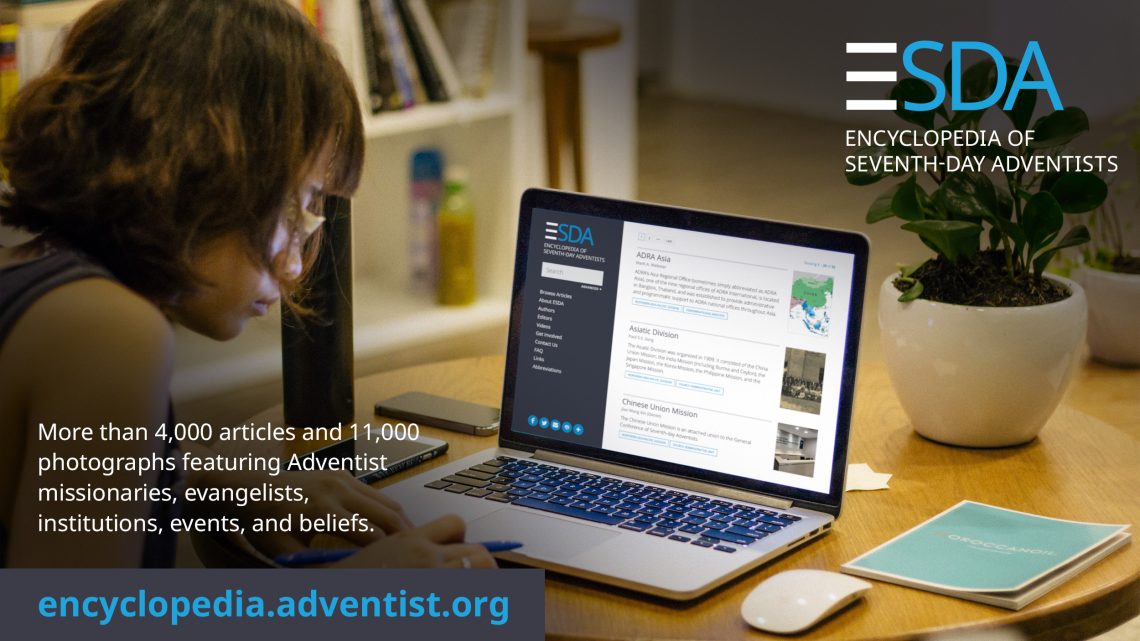On a hot summer afternoon in Keene, Texas, in 2015, I sat in one of Southwestern Adventist University’s classrooms and listened as David Trim and Benjamin Baker introduced a brand new project from the General Conference of Archives, Statistics, and Research. I was attending the annual Association of Seventh-day Adventist Librarians conference, and staff from the GC Archives were introducing plans for the new Encyclopedia of Seventh-day Adventist (known as ESDA), a project approved at the recent General Conference Session. Although painfully aware of the need for an updated encyclopedia of Adventist history, I little imagined how involved I would become in this project.
As a Union College library director and archivist, who assisted students of Adventist history with their research, I’d almost stopped recommending the old 1996 2nd revised edition of the Seventh-day Adventist Encyclopedia. Published as two add-on volumes to the Seventh-day Adventist Bible Commentary series, nearly twenty years later, it was woefully out of date. It excluded anyone of importance who had died after its publication, nor did it include the many changes denominational institutions had undergone since then. In an increasingly diverse church, the encyclopedia was starkly biased toward white males of northern European descent in both content and authorship. Furthermore, its unsigned articles lacked bibliographies. By 2015 I was much more likely to direct students to the recently released one volume Ellen G. White Encyclopedia (2014). While still lacking more recent topics, it provided longer signed articles and cited basic sources.
On that scorching summer afternoon in 2015, I knew that I wanted to contribute an article about the Seventh-day Adventist Medical Cadet Corps. I was just afraid I would not be considered a qualified author. A needless concern. After approaching then-managing editor, Benjamin Baker (2015-2017), he was delighted to consider my proposal. A year later when Union College was asked to compile a list of potential biographical articles about influential faculty members who had not been included in the 1996 encyclopedia, I was asked to write more than twenty articles. That was only the beginning.
In 2018, I was invited to join the ESDA team of editors and research assistants as a copy editor for the articles arriving from what was estimated to reach 1,500 different authors, and since that time my role has expanded to content editing, too; even as I continue to add to the list of articles I’ve written. Along the way, I have learned so much about our wonderfully and delightfully diverse church. From well-written, fully documented works of scholarship, such as those about Noah Wilson Allee or the Glacier View Sanctuary Review Conference (1980), to biographies of never-before-covered, little-known local leaders, such as Paul Kwame Owusu Ansah, whose only sources are oral history, ESDA represents every corner and aspect of the Seventh-day Adventist Church. . .or at least it will when completed. I have had the joy of writing nearly forty articles, and the adventure of turning broken English into coherent prose in even more. My librarian research skills have been put to the test as I attempted to improve poorly documented work and peer reviewed other articles. All the while, the goal is to preserve a taste of the breadth and the kaleidoscopic variety of a worldwide movement.
Under the leadership of David Trim, executive editor, and Dragoslava Santrac, managing editor, ESDA was officially launched on July 1, 2020. As I write, ESDA has published just shy of 4,000 articles contributed by 1,545 authors from around the world. Each division of the Seventh-day Adventist world church is represented by the work of editors and authors from that region of the world. Our North American Division editorial team includes Douglas Morgan, Michael Campbell, Dennis Pettibone, and Heidi Olson Campbell in addition to myself and a few others. Authors range from students and new young scholars to established church historians, pastors, conference officials, and lay church members with significant knowledge of their topics.
However, if those numbers seem large, there are still more than 3,000 topics on the list to be completed. That means there is yet room for new authors and peer reviewers to join the project. If you are a current or retired teacher, pastor, church administrator, or any church member with adequate knowledge about a topic yet to be covered in ESDA, love research, and can communicate well in writing, consider volunteering. Information about how to become involved is available at Get Involved or email ESDA through Contact Us. If you’re interested in receiving updates about ESDA’s progress, follow the project on Twitter (@EncyclopediaSDA), Facebook (Adventist Archives), and Instagram (@AdventArchives), or watch ESDA stories on the Adventist Church YouTube and ASTR YouTube channels.
Note: This post is a break from my usual factual research-based writing. All opinions are my own.










